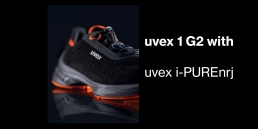Energy return has long been an indispensable topic in the sports shoe industry, and is becoming increasingly prevalent in the world of safety shoes, too. This of course raises the question of what energy return actually is. And what happens when it comes to work shoes? In this blog article, we take a look at these questions and what all this has to do with shock absorption.
Energy return – what is it exactly?
We can use the example of a rubber ball to explain the principle of energy return. When you drop a ball and allow it to fall to the ground vertically from a certain height, the ball absorbs energy as it falls, then bounces off the ground and releases some of the absorbed energy again as it does so. However, the ball does not reach its starting height again as part of the energy is converted into the deformation of the ball when it hits the ground. The same principle can be applied to shoes and walking.
Every time a person takes a step, a multiple of their own body weight acts upon the knees, muscles and ligaments. The human body already has several ways to absorb energy and, to a certain extent, return it in order to optimise movement patterns. Work shoes with a midsole that returns energy can therefore provide the wearer with extra support and prevent muscle fatigue. But how do shoes return energy? The impact forces that act on the sole when walking are absorbed by the sole in the form of energy and then released again when the wearer pushes off the ground. This means the muscles have to “work” less, preventing symptoms of fatigue.
Work shoes with shock absorption and energy return – why do we need both?
However, energy return isn’t enough. A work shoe must also offer a certain amount of shock absorption (or energy intake) in order to cushion the impact on the foot when walking or in the event of a fall. But when do we need shock absorption and when do we need energy return? To answer this, let’s take another closer look at the rolling movement of the foot when walking. We start by placing the heel on the ground, before rolling over the metatarsus, and then push off the ground with the forefoot.
This means that a high level of shock absorption is essential when a person’s full body weight acts upon the foot. This reduces the impact on the knees, ligaments and tendons when the heel strikes the ground. By contrast, a high level of impact energy return supports the muscles during the forward movement as the forefoot pushes off the ground. To put it simply, high shock absorption in the heel area and high energy return in the forefoot area provides vital support for the wearer.
Safety shoes with shock absorption that claim to provide a high level of energy return are already available on the market. However, the material used in these shoes cannot be applied across the entire outsole, only in the heel area. This means that the forefoot area – in other words, the place where high energy return provides the most support to the wearer – contains no material with energy return.
uvex i-PUREnrj – bursting with energy all day long
uvex has used these biomechanical findings to develop the innovative uvex
i-PUREnrj sole technology. The unique uvex i-PUREnrj sole material successfully combines energy return and shock absorption in one material across the entire outsole. The material returns the impact energy to the wearer across the entire sole and combines this with long-lasting, optimal shock absorption. This leads to far less foot and leg fatigue, for a full working day bursting with energy. This has also been verified in independent tests:
- 100% higher energy absorption than that specified by the EN ISO 20345 standard
- 66% energy return in the heel*
- 59% energy return in the forefoot area*
- 29% higher shock absorption than standard polyurethane soles after 1000 km of use*
- 21% less perceived fatigue than with standard polyurethane soles after a working day


Please send me more information about uvex safety shoes.
Hello,
for more information about our safety shoes please visite our website: https://www.uvex-safety.com/
Kind regards,
uvex safety